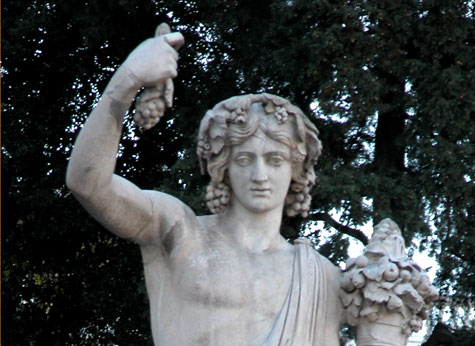Among the many benefits of my recent trip to Peru were new insights into the literature I teach. For instance, my encounter with Peru’s locally brewed corn beer, known as chica, has given me an appreciation for Teiresias’ encomium on wine in The Bacchae.
We visited a small bar in Urubamba (in the Sacred Valley of the Incas) to learn how chica is made. We sampled both plain and strawberry chica, the latter known as frutillada. Plain chica costs about 33 cents a glass while frutillada is twice that.
While the alcohol content isn’t high, from what I can tell the Andean farmers drink it non-stop. This is understandable given how hard they work. Much of the sowing and reaping is done manually, and pack animals are often used to transport the crops.
With this in mind, I looked up Euripides’ play when I returned. Here is Teiresias chastising King Pentheus for disrespecting Dionysus:
This new God whom you dismiss,
no words of mine can attain
the greatness of his coming power in Greece. Young man,
two are the forces most precious to mankind.
The first is Demeter, the Goddess.
She is the Earth—or any name you wish to call her—
and she sustains humanity with solid food.
Next came the son of the virgin, Dionysus,
bringing the counterpart to bread, wine
and the blessings of life’s flowing juices.
His blood, the blood of the grape,
lightens the burden of our mortal misery.
When, after their daily toils, men drink their fill,
sleep comes to them, bringing release from troubles.
there is no other cure for sorrow.
As far as I could tell, the Peruvian farmers don’t wait until after their daily toils are done to drink their fill, and I suspect they have other cures than chica for their sorrows. In fact, people generally seemed cheerful. But they certainly regard chica as a blessing and maybe chica helps explain their attitude.
I also saw a version in Peru of Teiresias’ praise of Demeter. Our guide spoke frequently of his reverence for “the Mother”—the male sun and the female moon were paired in Incan religion—and the Virgin Mary appears to have merged with the Incan fertility goddess Pachamama in Peruvian Catholicism.
Perhaps one can compare Pentheus to the Spaniards, insisting on their sky god at the expense of fertility earth gods. On the other hand, while I know very little about Peru’s religious history, I sense that the Spanish were less rigid than Pentheus. For instance, unlike Pentheus they allowed raucous dancing to continue. The Feast of Corpus Christi resembles the old celebrations of the 14 Incan emperors only the Spanish smartly substituted 14 Christian saints while keeping everything else the same. Maybe it’s because the Peruvians were allowed to hold on to many of their Incan religious symbols and traditions that the Spaniards didn’t suffer Pentheus’ fate.
But I began this post with beer so let me end it there. My students are always very intrigued by the idea of worshipping a god of fermented fruit.


